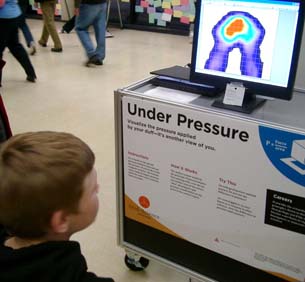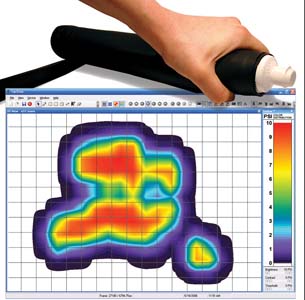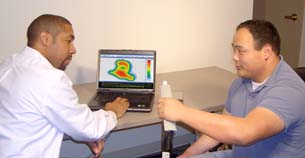Fast App: Sensor Product’s Tactilus Sensor System Enables Pressure Body Mapping
How are mattresses designed for different body types and shampoo bottles shaped to closely match the size of your hand? The answer is: pressure body-mapping technology.
May 24, 2010
By DE Editors
 Figure 1. A child sits and watches his body map change on the Tactilus sensor system display. (Courtesy of Sensor Products.) |
Interactive exhibits make learning science fun. One such exhibit, “Under Pressure,” demonstrates how pressure between the body and a contacting object—such as a chair—can create pressure points and strain. Sensor Products Inc., an innovator in the field of body mapping, donated its Tactilus system to The Leonardo Museum, a science, technology, and art center located in Salt Lake City, UT (Figure 1). The museum will be showing the exhibit at schools and libraries until 2011, when its new building opens. Joe Andrade, the exhibit developer and a professor of bioengineering at the University of Utah, integrated the system into a portable kiosk that teaches children and adults about surface pressure body mapping.
“The kids and adults really love it,” says Andrade. “They chuckle and can’t wait to sit on the pressure pad to see their body maps. Meanwhile, they are learning about science and technology.”
“We are delighted to share pressure body mapping with visitors at The Leonardo,” says Jeffrey Stark, president of Sensor Products. “This technology is becoming more prevalent and is of increasing benefit.”
 Figure 2. Tactilus characterizes pressure distribution and magnitude. (Courtesy of Sensor Products.) |
Body Mapping
In pressure body mapping, sensors collect data from the force exerted by the human body as it touches another surface. The data is then converted into color-coded body maps that correspond to different degrees of pressure. Armed with this knowledge, designers and engineers modify their products to produce more even distributions of pressure on the human body. By taking the load off areas with red hot spots—the locations of greatest pressure—products become more comfortable, ergonomic, and efficient.
According to Sensor Products, its body-mapping projects have been evolving. Designers are customizing mattresses to accommodate different body types. Engineers are modifying the shape of plastic tubes and bottles to make them easier to squeeze. And golfers are changing their swing when they see how the force of moving their feet affects their shift and balance.
The Technology
Sensor Products’ Tactilus body-mapping interface system is a matrix-based tactile surface sensor. Essentially an “electronic skin,” the sensing system records and interprets pressure distribution and magnitude between any two contacting, or mating, surfaces and assimilates the data in a powerful yet user-friendly Windows-based toolkit (Figure 2). Tactilus consists of a sensing element, signal conditioning electronics, and analysis software. In addition to body mapping, the same sensor system is also being used to measure the real-time contacting force of diverse industrial applications, such as wafer polishers, heat sealing, heat sinks, military armor, door seals, and tire treads.
| ||||||||||||||||||||||||||
Each Tactilus sensor is assembled to exacting tolerances and individually calibrated and serialized. Tactilus’ modular architecture enables portability, easy expansion, and simultaneous data collection of as many as six discrete sensor pads.
The system uses sophisticated mathematical algorithms that separate signal from noise, as well as advanced electronic shielding techniques to maximize immunity to environmental noise, temperature, and humidity. The proprietary sensor design ensures robust performance.
The various body-mapping sensor systems powered by Tactilus are designed to allow you to collect pressure, magnitude, and distribution data from selected locations across the human body, empowering you to select the precise location or locations, using fixed or free tactile surface sensors.
Designing Packaging
Pressure body mapping is helping engineers develop products that are not only more ergonomic but also less expensive to produce. A major consumer toothpaste manufacturer enlisted Sensor Products to help develop tubes that dispensed toothpaste within certain force parameters, with less costly material construction.
 Figure 3. A subject uses the Tactilus sensor system to demonstrate the pressure needed to squeeze a toothpaste tube. (Courtesy of Sensor Products.) |
The client assembled a focus group to test different types of prototype packaging with Tactilus and asked the test subjects to squeeze all the toothpaste out of a tube (Figure 3). The pressure required to squeeze the packaging was measured along the tube, including that present during the common practice of rolling the tube up to exact every ounce of toothpaste. The project established quantitative and qualitative pressure measurements of the squeezing effort. This created a baseline that packaging engineers could use in the future to precisely measure and improve their product standards.
More Info
The Leonardo
Subscribe to our FREE magazine, FREE email newsletters or both!
About the Author
DE’s editors contribute news and new product announcements to Digital Engineering.
Press releases may be sent to them via [email protected].






